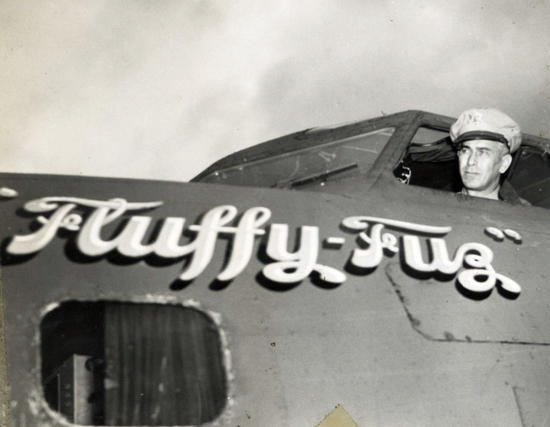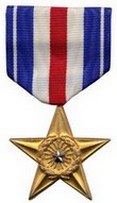Frank Armstrong
Ballplayers Decorated in Combat
| Date and Place of Birth: | May 24, 1902 Hamilton, NC |
| Date and Place of Death: | August 20, 1969 Tampa, FL |
| Baseball Experience: | Minor League |
| Position: | First Base |
| Rank: | Lieutenant General |
| Military Unit: | USAAF |
| Area Served: | European and Pacific Theaters of Operations |
Frank A. Armstrong, Jr., was a highly decorated
military leader, pioneering pilot, and minor league baseball player. He
led the first and last USAAF strategic bombing missions of WWII,
inspired the novel "Twelve O'Clock High," and served with distinction
for 34 years.
Frank A. Armstrong, Jr., was born on May 24, 1902
in Hamilton, North Carolina. The son of Frank (a machinist) and Annie
Armstrong, he had an older sister, Hazel, and a younger sister, Mary,
who was born in 1905.
He attended Wake Forest College (now University)
where he played baseball and football. During the summer of 1921, he
played first base for the Kinston team in the outlaw Eastern Carolina
League, an "outlaw" league since
it existed outside of the law of the National Association, something
that could have jeopordized his ability to play college sports. On the
sports field, Armstrong was a hard worker as a half back and first
baseman, but not much more than a good substitute until Hank Garrity,
former Princeton quarterback, arrived at Wake Forest as the new coach in
1924. Under Garrity’s guidance in both sports, Armstrong developed into
one of the safest backs on the championship football team and was
captain (and batted clean-up) for the baseball championship team his
senior year.
Graduating in 1925, Armstrong signed with the
Detroit Tigers in June and was sent to the Toronto Maple Leafs of the
Class AA International League. The Maple Leafs assigned the first
baseman to the Kinston Eagles of the Class B Virginia League, where he
played 15 games and batted .250 before joining the Raleigh Capitals of
the Class C Piedmont League for 10 games.
During the off-season Armstrong taught and coached
the football team at Selma High School in North Carolina, returning to
the minors in 1926 with the Sarasota Gulls of the Class D Florida State
League. The 24-year-old played 68 games in what was to be his last
season in organized baseball, batting .253. Armstrong was dating
Vernelle Hudson of Richmond, Virginia, at that time. “She said she would
never marry a man with no more ambition than to play baseball,” he later
recalled, “[so] I decided to enter the Air Corps.”
Armstrong embarked on an exhilarating journey,
earning his pilot's wings and setting the stage for an extraordinary
military career. In March 1929, he tied the knot with Vernelle, and
their adventure continued with the arrival of their only child, Frank
III, in March 1930.
Armstrong's career took off at Langley Field,
Virginia, with the 2nd Bomb Group, and soon he was training future
pilots at March Field, California. By 1931, he was shaping the next
generation of aviators at Randolph Field, Texas, and climbed to the rank
of first lieutenant in October 1934. His adventures continued as a
pursuit pilot in the Panama Canal Zone later that year. In Panama on
November 30, 1925, as a sign of things to come for Armstrong, he was
awarded the Distinguished Flying Cross for his skill in landing a
Douglas OA-4A Dolphin amphibious flying boat after the right engine had
exploded and the rest of the crew had been ordered to bail out.
In March 1937, Armstrong joined the 13th Attack
Squadron at Barksdale Field, Louisiana, mastering the Northrop A-17
Nomad single-engine attack planes. By May 1939, he commanded the
squadron, leading it through its transformation into the 13th Bomb
Squadron (Light) with twin-engined Douglas B-18 Bolo bombers.
With Europe engulfed in war, Armstrong was thrust
into action, heading to England as a combat observer with the Royal Air
Force in November 1940. By February 1941, he was back in the States,
taking command of the 90th Bomb Squadron at Savannah Army Airfield,
Georgia. His rapid rise continued as he was promoted to major that year
and then to lieutenant colonel in January 1942, becoming the Assistant
Chief of Air Staff of Operations at US Army Air Forces headquarters in
Washington, DC.
Shortly afterwards, Armstrong teamed up with
Brigadier General Ira Eaker and headed to England to establish the
legendary 8th Bomber Command, 8th Air Force. As the operations officer,
he quickly rose to the rank of colonel. By July 1942, he was at the helm
of the 97th Bomb Group, the first squadron of Boeing B-17 Flying
Fortress bombers to reach England. From August to September 1942,
Armstrong fearlessly led the 97th on six of its first 10 missions,
including the groundbreaking first daylight heavy bomber raid over
Nazi-held Europe by the USAAF. In January 1943, he took command of the
306th Bomb Group and spearheaded the 8th Air Force's inaugural mission
to bomb a target in Nazi Germany. Armstrong's daring exploits inspired
the novel "Twelve O'Clock High" by Sy Bartlett and Beirne Lay, Jr., with
Gregory Peck immortalizing the book’s character of Brigadier General
Frank Savage in the 1949 film adaptation, and Robert Lansing bringing
him to life in the 1960s ABC television series.
In February 1943, Armstrong, aged 40, was promoted
to the rank of brigadier general and became commander of the 101st
Provisional Combat Wing, continuing to fly combat missions over Germany.
On April 5, 1943, Armstrong was flying as an observer on a B-17 raid on
Antwerp, Belgium, when the plane was hit and the navigator – Captain
Robert J. Salitrnik - in the nose of the plane, was badly wounded. The
blast knocked out the bomber’s hydraulic control and oxygen systems and
damaged the propeller. With German fighters still attacking the
formation, causing a fire in the cockpit, Armstrong grabbed an oxygen
bottle and rushed to the aid of the navigator, who was bleeding from a
leg wound. Armstrong applied a tourniquet and administered first aid.
For this action, Armstrong was awarded the Distinguished Service Cross.
Sadly, Salitrnik died 11 days later.
By June, he was leading the 1st Bombardment Wing.
In September 1943, he returned to the U.S. to command the 46th and 17th
Bombardment Operational Training Wings at Peterson Field, Colorado.
November 1944 saw Armstrong commanding the 315th Bomb Wing at Peterson
Field, training with the mighty Boeing B-29 Superfortress. Between March
and April 1945, his wing was deployed to Northwest Field, Guam, to
launch missions against Japan. Also at Northwest Field was Major
Clarence “Soup” Campbell, squadron executive officer with the 16th Bomb
Group, and former outfielder with the Cleveland Indians.
On August 15, 1945, Armstrong led the longest and
final heavy bombing raid of the war, earning the incredible distinction
of having led both the first and last USAAF strategic bombing missions
of World War II.
With the war over, Armstrong made history in
November 1945 by flying the first non-stop flight from Hokkaido, Japan
to Washington, DC in a B-29 Superfortress. In January 1946, he became
the Chief of Staff for Operations of the Pacific Air Command, US Army.
When the US Air Force became a separate branch in September 1947, he
served as deputy commanding general of the Alaskan Air Command at Fort
Richardson, Alaska, until February 1949, and then as its commanding
general until December 1950.
In January 1951, Armstrong took command of Sampson
Air Force Base, New York. By May, he was leading the 6th Air Division,
training the first Boeing B-47 Stratojet Wing at MacDill Air Force Base,
Florida. In 1952, he became the commander of the 2nd Air Force of the
Strategic Air Command at Barksdale Air Force Base, Louisiana. Armstrong
returned to the Alaskan Air Command in July 1956, and upon his promotion
to lieutenant general, he commanded the Army, Navy, Air Force, and
Marines Alaskan Command at Elmendorf Air Force Base, Alaska. He retired
in July 1962, capping off an incredible 34-year military career.
Among his decorations during those years were the
Distinguished Service Cross, the Distinguished Service Medal (with one
oak leaf cluster), the Silver Star, the Distinguished Flying Cross (with
four oak leaf clusters), the Air Medal (with one oak leaf cluster), the
British Distinguished Flying Cross and the Belgian Croix de Guerre (with
palm).
After retiring, Armstrong and his wife, Vernelle,
settled in Tampa, Florida, a place filled with memories from his time at
MacDill Air Force Base, and worked for the Automatic Merchandising
Company, which operated and installed vending machines. Tragically,
Vernelle passed away in February 1963, at the tender age of 54, leaving
a void in Frank's heart after 34 years of marriage. In December 1963, he
married, Peggy Lippe, owner of the Tampa Blueprint Company.
His son, Frank III, followed in his footsteps and
served with the Air Force as a pilot. After flying jet fighters in
Germany, he requested to serve in Vietnam in 1967. Just six weeks into
his deployment, Major Frank Armstrong III was wounded by shrapnel and
had to eject from his Douglas A-1E Skyraider single-seat piston-engined
attack plane when it was hit by enemy flak. He returned to Florida in
August to recover, spending precious time with his father and
stepmother, his wife Vera, and their young son, Frank IV.
Tragically, Major Armstrong returned to Vietnam and
was shot down again on October 6, 1967. This time, he did not survive,
and his body was never recovered. He is remembered at the Honolulu
Memorial in Hawaii, and the Vietnam Memorial Wall in Washington, DC.
Reflecting on his son's bravery, his father said,
“I am certain that he scheduled himself to fly this mission…It wouldn’t
be like him to send other pilots out to take fire that he wouldn’t take
himself.”
Less than two years later, Frank Armstrong was
admitted to Tampa General Hospital in a critical condition on August 6,
1969. The 67-year-old passed away two weeks later, on August 20. He was
laid to rest with full military honors at Arlington National Cemetery in
Virginia, alongside his first wife, Vernelle. His second wife, Peggy,
passed away in March 1973, at the age of 55.
|
Year |
Team |
League |
Class |
G |
AB |
R |
H |
2B |
3B |
HR |
RBI | AVG |
| 1925 | Kinston | Virginia | B | 15 | 56 | - | 14 | 2 | 0 | 2 | - | .250 |
| 1925 | Raleigh | Piedmont | C | 10 | 43 | - | 8 | 2 | 1 | 0 | - | .186 |
| 1926 | Sarasota | FSL | D | 68 | 237 | - | 60 | 5 | 1 | 0 | - | .253 |



Frank Armstrong (back row, third from left) with his B-17 crew in England

Frank Armstrong in the cockpit of his B-17. Fluffy was his nickname for his wife, Vernelle.


Frank and Vernelle Armstrong
Date Added November 28, 2024
Can you add more information to this biography and help make it the best online resource for this player? Contact us by email
Read Baseball's Greatest Sacrifice Through The Years - an online year-by-year account of military related deaths of ballplayers
Baseball's Greatest Sacrifice is associated with Baseball Almanac
Baseball's Greatest Sacrifice is proud to be sponsored by






